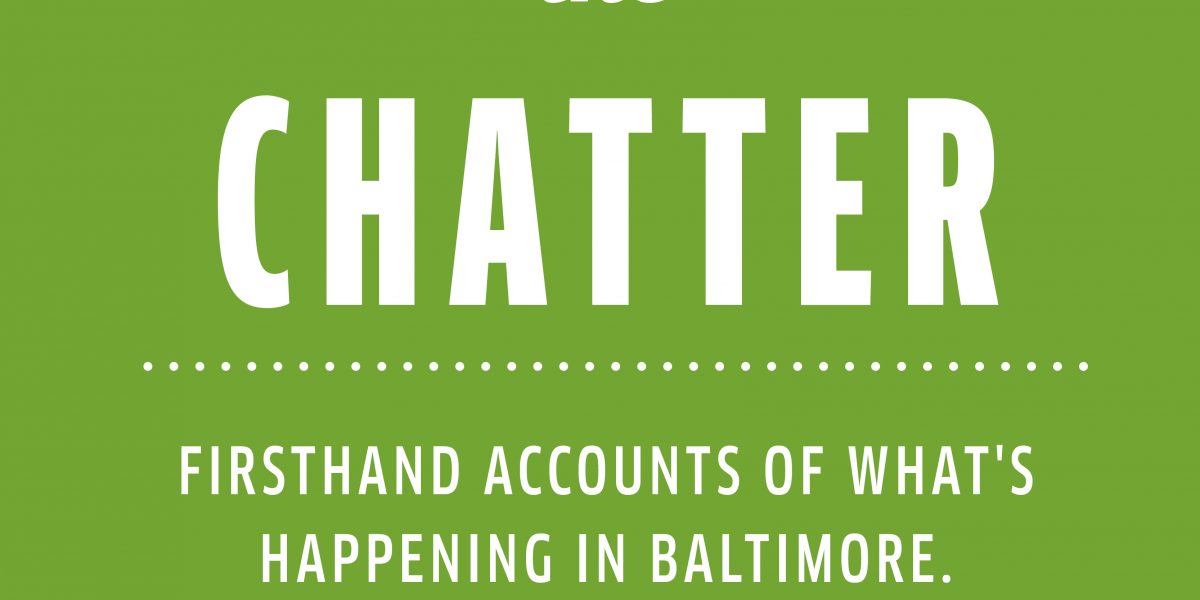News & Community
The Chatter: December 2014
Firsthand accounts of what's happening in Baltimore.
Rain or Shine
October 13, 2014
North Payson Street
Marvin “Doc” Cheatham stands with other volunteers in Matthew A. Henson Elementary School’s lobby, next to a mural of Thurgood Marshall, Eubie Blake, Frederick Douglass, and other great Baltimoreans, including Henson, the first African-American Arctic explorer. This morning marks the 4th-annual Michael Carter Men Reading in Baltimore City Public Schools Initiative, a series founded by Cheatham and named after a longtime city schools advocate. It’s more about the male role models than it is about reading. “This is the hook,” Cheatham says. “The hope is the men will become more engaged with local schools.”
Later, encouraging the children in Ms. Copeland’s pre-K class to circle around him, Cheatham takes off his jacket and begins reading Dr. Seuss’s One Fish Two Fish Red Fish Blue Fish. Then he stops himself. “Are you okay? Are you shy today?” he asks a boy in the back. “C’mon up here and sit next to me.” Most of the children are enthralled, but Cheatham interrupts himself again, addressing another quiet boy. “C’mon, you come up here, too, and sit on my other side.” Finishing the tale, Cheatham, a retired government worker who grew up and still lives nearby in West Baltimore, echoes the words of principal David Guzman, reminding the kids they need come to school every day, even when it’s raining or snowing. “My name is ‘Mr. Cheatham,’ which sounds a little funny, right?” he continues to rapt attention. “If your parents can’t bring you to school—you tell them to call Mr. Cheatham, and I’ll come get you.”
Hollywood Dreams
October 14, 2014
Jarrettsville
Anxious production assistants hustle in and around the wardrobe and prop trucks parked behind the Jarrettsville Volunteer Fire Company, serving today as the back lot of the award-winning House of Cards. Inside, 75 extras chow on a catered breakfast before getting shuttled to the set—a nearby barn—where the real-life retirees, housewives, and cable guys will portray rural Midwestern voters. Dressed in jeans, boots, and flannel shirts for a town-hall-style meeting, everyone is soon perspiring—water bottles are handed out—under the bright lights as stars Robin Wright and Kevin Spacey take turns delivering lines from the stage. “I know it’s warm, so we are going to open this big door behind me,” says Spacey, still channeling conniving South Carolina congressman-turned-President Frank Underwood during a break. “We’ll let in that cool air outside,” he tells the crowd of extras, soaking up the performance, in Underwood’s thick, faux empathetic drawl, “to offset all the [political] hot air coming from this podium.”
Many compare notes about recent extra work on HBO’s Veep, also shot in Baltimore, and past gigs. One man recounts a no-line part as a waiter on the 1970s soap Dallas, serving Larry Hagman (“I remember his cowboy hat to this day”); his TV wife, Linda Grey; and the woman who played Hagman’s mother, Barbara, Bel Geddes. “Funny thing was, years later, I get a call from a friend I hadn’t heard from in a long time. Guess the first thing he says? ‘Were you ever on Dallas?’ He’d seen a rerun somewhere.
“Of course, I asked him how I looked. He says in all seriousness, ‘You totally nailed it, Dude.’ And we cracked up.”
Heaven’s Gate
October 25, 2014
Greenmount Avenue
On a picnic-perfect fall morning, almost four-dozen people, many with cameras, gather inside the stone and iron entrance to Green Mount Cemetery, which is celebrating its 175th anniversary this year. Former city teacher Wayne Schaumburg has been leading tours here—the final resting place for a “Who’s Who” of Victorian Baltimore, including Johns Hopkins, Enoch Pratt, and Henry Walters—since 1985, first as a volunteer with the now-defunct City Life Museums. Every tour still sells out.
Built on 68 rolling acres in East Baltimore’s Oliver neighborhood, then considered “the countryside,” Green Mount is home to stunning bronze works by major sculptors William H. Rinehart and Hans Schuler, as well as 65,000 people in repose. “But you won’t find a lot of snappy epithets,” Schaumburg says beneath the yellow and red leaves of the cemetery’s massive trees. “The ones you do see, usually refer to eternal ‘sleep’ or ‘rest.’ Life was hard then and for Victorians death was often viewed as a release.”
Privately owned, Green Mount catered to Baltimore’s upper-middle and upper classes—which doesn’t mean that there haven’t been controversial and colorful characters buried on the grounds. Elizabeth Patterson Bonaparte, once sister-in-law to Napoleon, is interred at Green Mount. Also among the buried: John Wilkes Booth, Lincoln’s assassin; Johnny Eck, Baltimore’s famous “half-man” sideshow performer; and Elijah Bond, patentee of the Ouija board.
Former Mayor William Donald Schaefer also purchased a plot, Schaumburg heard, but later decided, apparently, not to be buried among the noted politicians, philanthropists, and industrialists. Instead, Schaumberg notes, “Willie Don” lies forever alongside his longtime companion, Hilda Mae Snoops, at Dulaney Valley Memorial Gardens Mausoleum.
“He’s one that got away.”
